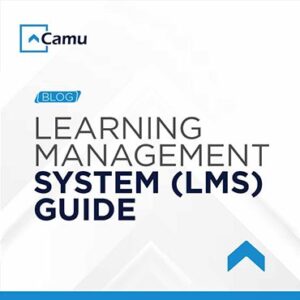
Guide on Accreditation
What is Accreditation
Accreditation is assessment of the quality of an institution through a multi-layered process. Through the accreditation process, an assessment is carried out to ensure that an institution has the necessary policies, practices and standards and that those standards are being met. Using predetermined requirements and criteria of educational quality, a third party conducts a detailed evaluation of the institution. The results of the evaluations help the institution build its accountability and gain public confidence and trust.
Given below are some of the steps included in an accreditation process –

- Standards:The accrediting body which may be constituted by the government or by a private agency reviews the standards of the institution and identifies if such standards are being met.
- Self-Study:Before the accrediting body conducts its evaluation, the institution must do a self-study and identify its weaknesses and strengths. They will present this self-evaluation report to the accrediting body which will verify the points that are laid out.
- On-site Evaluation:The accrediting agency conducts an on-site evaluation. This evaluation is carried out by a team of experts and professionals in the field of academics and administration. This team analyzes the self-study report sent in by the institution and further evaluates if the said institution is eligible for accreditation. The evaluation will include a review of records and interviews with employees of the institution.
- Grant of accreditation: Based on the evaluation, the institution may be given accreditation if they have met all the requirements. The institution should be able to prove their records and standard of functioning are meeting such requirements as set by the accrediting body.
- Certificate of Accreditation: The institute is given a certificate of accreditation. They will also be notified of the next date for accreditation. Accreditation certificates can be made public by the institute but they must ensure their accuracy.
NAAC Accreditation
In India, the National Assessment and Accreditation Council (NAAC) was established in 1994 under the University Grants Commission (UGC). As per its vision statement, the aim of NAAC is to make ‘quality assurance an integral part of the functioning of Higher Education Institutions.’ The NAAC is composed of a General Council and an Executive Committee where the members are policymakers, senior academicians and educational administrators. The factors of evaluation under NAAC include the institution’s educational processes and outcomes, curriculum coverage, teaching-learning processes, faculty, research, infrastructure, learning resources, organization, governance, financial well being and student services. As per the evaluation, institutions are ranked from A++ to C. When an institution is ranked D, it means the institution has failed to meet NAAC’s criterion.
The grading is carried out using letter grades that are converted to Numerical Grade Points with the qualitative measurements also converted to grade points. The CGPA system of grading is used as it decreases the chance of any biases and there is a wider scope of normalizing the scores. As there may be differences among the inter-peer team assessments, using CGPA reduces the variations that may arise. After the institution is graded under each criterion, the GPA is calculated for each criterion. In the final step, taking together the GPA of each criterion, the cumulative GPA is calculated. This cumulative GPA becomes the final assessment outcome. If the institution is not satisfied with the assessment, they can submit a grievance redressal. This appeal can be made fifteen days after the result of the accreditation and assessment has been declared. The appeal can be made online with prescribed performa and a non-refundable fee of Rs. 50000. However, the submission of appeal cannot be made later than 45 days from the date the results have been declared on the NAAC website. To ensure maximum transparency, NAAC consults the institution at various stages of the assessment and accreditation process.
The final outcome of the NAAC assessment is given as an ICT based score combining the qualitative and quantitative metrics. This assessment document is divided into three parts as follows –
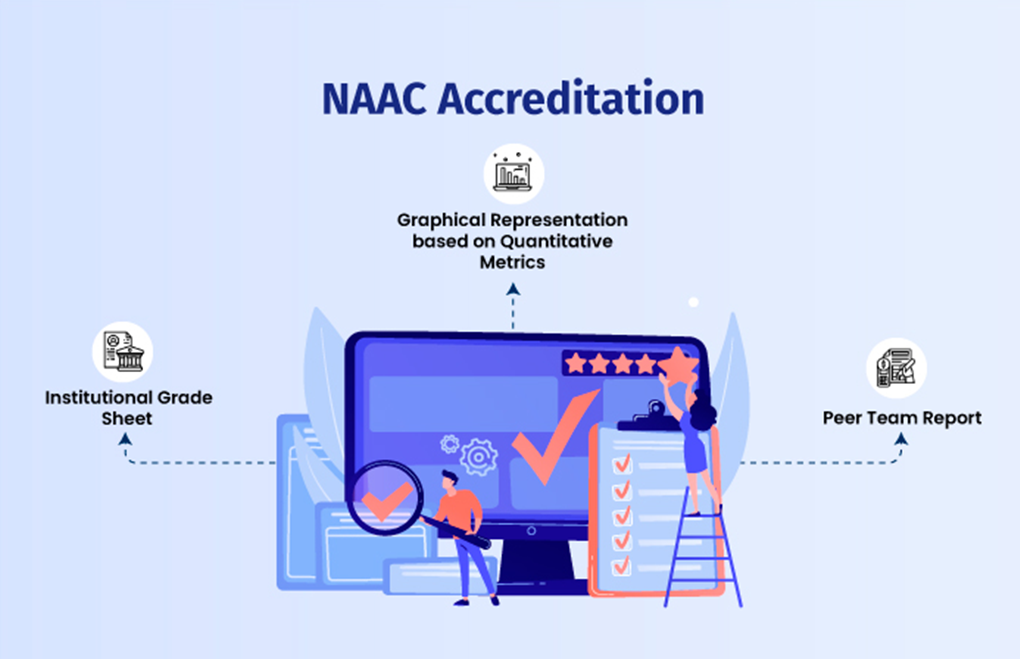
- PEER TEAM REPORT:This report lays out in detail the general information of the institution as well as the evaluation report as per qualitative indicators. The strengths and weaknesses of the institution are published in this report.
- GRAPHICAL REPRESENTATION BASED ON QUANTITATIVE METRICS:This part of the report contains the System Generated Quality Profile of the institution as per the quantitative indicators. These indicators are assessed as per the NAAC’s Quality Indicator Framework.
- INSTITUTIONAL GRADE SHEET: The score in this part of the report is compiled by software. The report contains assessments of qualitative indicators as well as quantitative indicators and results of student survey results.
Importance & Benefits Of NAAC Accreditation:
There are many important benefits of NAAC, such as –

- To identify institutions’ strengths and weaknesses:The accreditation results help an institution understand its strengths and weaknesses. Very often, an institution may be running its usual course without being able to identify its core strengths and areas where there is a need for improvement. For example, an institution may rank high in teaching-learning processes while its student services may be lacking greatly. Understanding its weaknesses gives the institution a chance to rectify errors and provide a better learning opportunity to its students.
- Attract Capital:Having a robust accreditation grade helps the institution gain public trust and confidence thereby increasing its chances of attracting capital for further development. Funding agencies tend to study the objective data of an institution before they make the decision on funding.
- Employers benefits: Academicians looking for employment may be able to select their institution choice based on its accreditation grade. Institutions with higher grades will improve their future prospects. The accreditation process conducted by institutions also helps understand the collegiality of the campus.
- Improve students prospects: Students looking to study in international institutions for further studies can have an advantage if they have studied in a highly graded institution. International institutions often look for the accreditation and quality of the prospective students’ former institution to understand and evaluate the quality of the student and determine their chance for admission.
- Gain public trust: One of the first questions that come to people’s minds when they are trying to find out the reputation of an institution is its accreditation status and grade. Any institution with a good accreditation and grade displays its accreditation status as widely as possible. This helps them earn public trust and confidence. The institution gains a good reputation for having a quality high enough to earn good grading by NAAC and is pursued by many aspiring students.
Things to keep in mind for NAAC Accreditation
There are various requirements that must be met for an institute to get accredited. These are some points to keep in mind when aiming for NAAC accreditation –
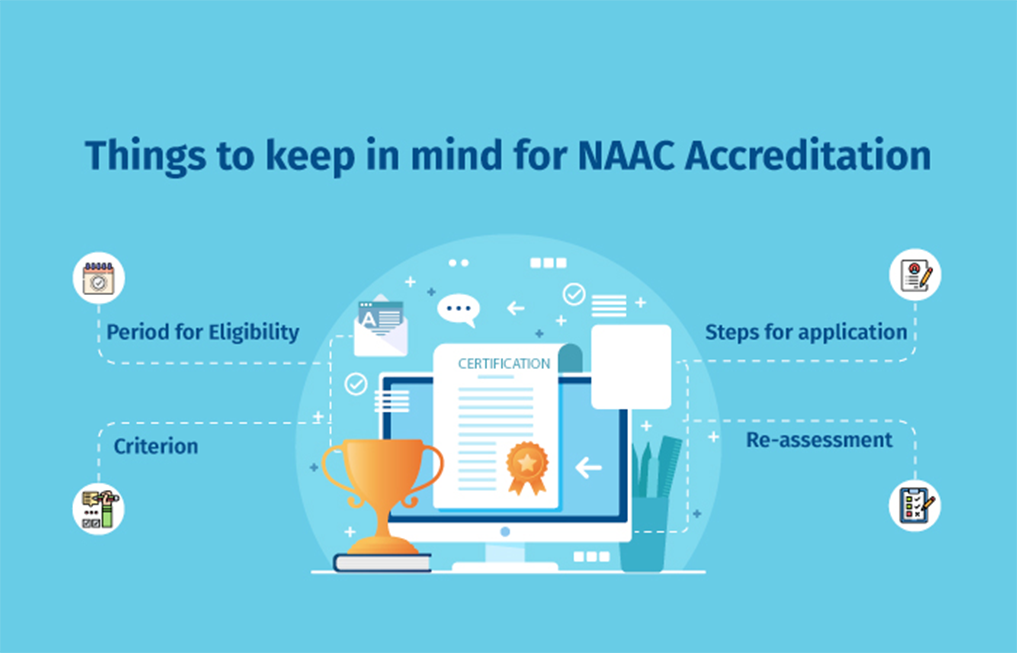
- Period for Eligibility:Colleges and Universities that have completed one academic year are eligible to apply for accreditation under the category of “Provisional Accreditation for Colleges.” Higher Education Institutes which have been in existence for 6 years or have at least two batches of graduates are eligible to apply for Assessment and Accreditation (A&A).
- Steps for application:The first step to being taken by an institute is to submit an application with a self-study report with detailed quantitative and qualitative metrics. In the second step, this report is evaluated by the accreditation board. For evaluation, a team of experts visit the institute and review the quality aspects. Finally, the qualitative and quantitative metrics are added up to come up with the final grading of the institution.
- Re-assessment: Institutes that are looking to apply for reassessment with an aim to improve their accreditation status can do so after a minimum of one year and before three years of accreditation. The evaluation by NAAC will also depend on their fulfillment of various conditions laid out by the accrediting board.
- Criterion: There are seven criteria under NAAC, namely, curricular aspects, teaching-learning & evaluation, research, innovation & extension, infrastructure & learning resources, student support & progression, governance, leadership & management and institutional values and best practices.
How Camu Helps in NAAC Accreditation
The Camu platform, through the use of advanced technology, helps colleges and universities achieve the academic excellence that they strive for. It is designed to help colleges and universities achieve accreditation by keeping track of their performance with centralised documentation services. The platform has different features such as choice based-multiple streams, Outcome-based education along campus management software including transport, hospital and library can also be managed. The Camu platform also helps the institute conduct examinations online, question papers can be set up in confidentiality and multiple choice questions and video tests can be conducted with the students under surveillance by teachers.
Some of the main aspects where Camu’s platform can be helpful for NAAC Accreditation are –

- Camu adopts all governance models – 90% compliance:Camu features over 90% compliance for accreditation regulations in over 6 countries. International recognition takes the reputation of the institution up a notch and empowers academicians and students to stand head to head with fellow internationally recognised institutions. An institution aiming to achieve international recognition can do so through the Camu platform. This platform adapts itself to different governance models in different countries.
- Holistic curriculums:Camu follows the system of Outcome-Based Education which is the key to achieving accreditation. Colleges and universities which practise and adapt to Outcome-Based Education (OBE) have much higher chances of getting accredited as the accreditation process analyzing curriculums and assessments are based on outcome attainment.
- Time-saving: Easy and simple audit processes through Camu analytics help point out any errors and drawbacks in areas that require management and rectification. It is a storehouse of information with over hundreds of audit reports accessible at one click of a button, saving time for the college administration.
- Cost Saving: The Camu platform not only helps the institution save time but also helps save on the costs incurred. There is less manpower required for the documentation and filing process using a cloud-based platform. Moreover, the time that is normally incurred in lengthy audit processes could be utilized for other productive purposes, thereby indirectly saving costs and increasing productivity.
- Improve teaching methodology: Camu platform helps improve the teaching methodology through the practice of outcome-based education wherein the teaching and learning methods are designed to be student-centric. The course and the assessment are compiled with a plan to achieve specific goals or outcomes.
- Easy audit and development report: The audit process is made easy as all files and documents are stored in this cloud-based platform. Developing reports also becomes a hassle-free task as data and statistics can be compiled quickly through the information stored in the platform. The datas cannot be manipulated as it is computerized completely. These audit reports can be retrieved even after many years and provide analytics on the data presented.
- Track compliance: The Camu platform makes it easy for institutions as well as accrediting bodies to track the level of compliance and the achievements or weaknesses of the institution. Colleges and universities can easily understand where they need to improve to keep up their compliance levels and attain accreditation.
Accreditation for AICTE
It is vital to assure the quality of technical education in India offered by several institutes, colleges and universities. They need to follow certain norms, qualities and standards for providing quality education to the students. This led to the formation of the statutory body known as the All India Council for Technical Education (AICTE), which is in charge of maintaining quality assurance and offering accreditation to technical organizations. Read this post to know more about What is AICTE, its advantages of AICTE to students and universities and the accreditation process.
What is AICTE
AICTE is the abbreviated form of All India Council for Technical Education, which was established in November 1945 as a national-level apex advisory body with an objective to inspect the facilities and provisions available for technical education in the institutes. This council comes under the Department of Education and received statutory body status by an Act of Parliament in 1987. AICTE is responsible for planning, developing the technical education system in India and maintaining the norms and standards by acting as a statutory authority.
AICTE is based in New Delhi and has several regional offices such as Bangalore, Bhopal, Chennai, Chandigarh, Guwahati, Hyderabad, Mumbai, Kanpur, Thiruvananthapuram and Kolkata. It has eight sub-departments including-

- Administrative Bureau
- Academic Bureau
- Engineering & Tech Bureau
- Finance Bureau
- Planning & Coordination Bureau
- Quality Assurance Bureau
- Research & Institutional Development Bureau
Advantages of AICTE
All the engineering colleges or the colleges that are offering the technical courses in India that come under the ambit of 10 statutory bodies of AICTE cannot offer these programs to the students without the approval of AICTE.
All the engineering colleges or the colleges offering the technical courses in India that come under the ambit of 10 statutory bodies of AICTE must need the approval of AICTE to offer their programs. The colleges have to apply to the AICTE for those offering the courses and then the council checks for the authenticity, credibility and quality of the programs. After the approval by AICTE, the colleges can offer the programs or courses to the students. So, the students must check that the college has AICTE accreditation for higher education.
Process of AICTE
To seek AICTE approval for the first time for their technical program or course, the institution needs to undergo the following steps-
#Step 1: The foremost step for the institute that is interested in receiving accreditation for AICTE must need to visit its official website https://www.aicte-india.org/ and then click on web portal login.
#Step 2: Click “Request user-id” on the homepage of the web portal and get the login credentials including the user id and password.
#Step 3: Once you receive the credentials on your registered e-mail id, use it to log in to the AICTE portal.
#Step 4: Click on the New Institute Application and read the instructions thoroughly and carefully.
#Step 5: Proceed further and create the application for AICTE approval through the new institute application.
#Step 6: Fill in the required details in the form such as organization details etc. Once it is completed, your page will land on the payment details. Fill in this information too.
#Step 7: After you fill in all the information details required in the form along with the payment, click on the submit button to send your online application.
#Step 8: Make the online payment by following the steps given under the payments tab. Check the required amount mentioned in the TER charged tab.
#Step 9: Print out the application form Part-1, Part-2 and Deficiency Report. Take the regular follow-ups from the AICTE headquarters through email, SMS or web portal to make sure that all the formalities of the AICTE approval are completed.
Conclusion
The process of accreditation for AICTE is quite difficult and complex. Therefore, it is necessary for the colleges or universities to be equipped with proper labs, infrastructure, faculty members and other faculties. Camu digital campus helps the HEIs to pre-scan reports with the help of easily operated ERP software. We are one of the most popular colleges and school ERP systems available in the market and have already helped 430+ institutions. Visit here to know more about us and our innovative features.
Accreditation for British Accreditation Council
The British Council is the UK’s international organization that builds the connections, understanding and trust between the people in the UK and overseas through quality education, arts and culture and the English language.
Before your institute or university or program is to be the leading mark of the British Accreditation Council, you must first understand well what is the British accreditation Council, its advantages to you and your students and the process of accreditation for the British Accreditation Council. So, here is the post dedicated to answering all these questions.
What is the British Accreditation Council
The British Accreditation Council for Independent Further and Higher Education, popularly known as BAC was established as a joint initiative between the British Council and the Department of Education in 1984. It is a non-profit organization with a registered charity. This is designed to set standards for the institutes or universities and help them to provide the quality assurance of education to the students. They have been working for more than over 30 years or for over the quarter of the century to enable trusted and recognizable accreditation in the UK and overseas.
BAC’s mission is to provide rigorous assessment-based accreditation for higher education, training programs, schools and universities to enhance the standards and quality. And the vision is to expand its accreditation and consultancy services in the UK as well as in the international markets.
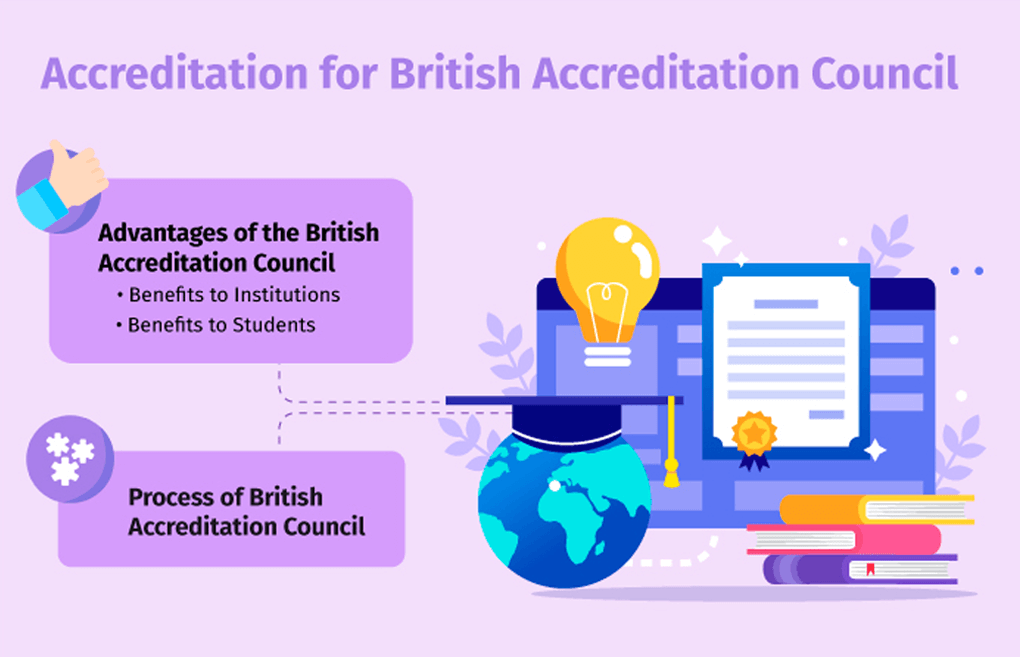
Advantages of the British Accreditation Council
| Benefits to Institutions- | Benefits to Students- |
|---|---|
| Gaining the BAC accreditation gives the institution a greater profile, credibility and international recognition. | Selecting the BAC accreditation school, university or any training program gives quality assurance to students and their families. |
| The UK and international endorsement for an institution, which is a globally recognized body. | If the standards and practices don’t fulfil or met, the student can be able to seek redress through an agreed complaint procedure. |
| Gives approval to their students to enter the lucrative international market through the Student Visitors Pass. | |
| Get expert advice and support in all the operational processes from the accreditation inspectors. | |
| Working with BAC will help the institutions to maintain a culture of continuous improvement and development. | |
| The robust and systematic process of inspection helps the institutes to enhance their quality and standards. | |
| BAC invites its member schools and universities to attend the tropical industry events providing the opportunities to grow the professional network and meet the experts face-to-face. |
Process of British Accreditation Council
The institutions considering the application for the British Accreditation Council must first know about the eligibility criteria and standards.
Any educational organization is eligible for accreditation providing the following requirements are met:-
- The educational organization offers training, vocation and further or higher education programmes.
- The institute must be able to provide evidence of its financial stability.
- The organization is led by a proprietor or designated principal or director, who is legally resident in its main country of operation and has clear documented responsibility for running the organization and the quality of its work.
- The effective control of the organization is the responsibility of account management.
- Such organizations that are solely or predominantly providers of full-time education for students of compulsory school age (students i.e. 16 years or under) are not normally eligible for accreditation.
Now, the process of accreditation follows as below:-
- First, the institution registers its interest in receiving accreditation by filling out the enquiry form.
- BAC aims to complete an initial due diligence check within five days. If the committee is satisfied with the standards and practices, they will invite the organization for an online meeting, in order to discuss their operation, management, academic curriculum and quality of admission enrollment and may also give suggestions for improvising.
- If the organization wishes to move forward, it registers its application by paying the Non-refundable application fee.
- The BAC will raise the invoice for the application fee and the inspection management fee.
- Then, the organization needs to submit all the supporting documents with the application along with the fee payment within 14 days of the invoice being sent.
- BAC strives to conduct the initial review of the application and documents within the first ten working days and communicate with the organization until satisfied that it meets the eligibility criteria and standards.
- If the new applications are not completed within the 6 months, BAC reserves the right to request the organization to start the process again and an additional application fee will be due.
- An on-site inspection is conducted by the inspector or the team for monitoring its premises and facilities in accordance with the excellence for BAC accreditation.
- The inspection report is drawn and submitted to the accreditation committee.
- BAC notifies the organization of the accreditation committee’s decision.
The Accreditation Committee makes one of the three decisions-
- Award Accreditation for the 4 years and to re-apply after that.
- Defers a decision- A time period is set for an organization to work on the relevant points and then they will undergo a new inspection.
- Refuse accreditation- if it is refused, then an institution must wait for a minimum of 24 months before re-applying.
Summing Up!
Accreditation for the British Council is an important feature for educational institutes but it is a long and tiring process. Camu Digital Campus offers world-class ERP solutions which make your accreditation process simpler. From auditing the operational report to financial and budget constraints, we facilitate the accreditations for educational organizations. For more detailed info, contact us or request a free demo session.
Accreditation for MQA
Before taking admission to any college or university, make sure it is accredited by MQA. But not sure what is MQA? Then, Buckle up. In this post, we are going to tell you about the MQA, its advantages and the process of accreditation for MQA.
What is MQA
The Malaysian Qualifications Agency or MQA is a statutory body which is governed by the Ministry of Education. It was established on 1st November 2007 with the coming into force of the Malaysian Qualifications Agency Act 2007. Then, it was officially launched by the Honorable Prime Minister of Higher Education on 2nd November 2007.
The primary objective of MQA is to carry out the Malaysian Qualifications Framework (MQF) to ensure the quality education of Malaysia’s higher education. It is recognized internationally and is completely responsible for monitoring and overseeing the quality assurance practices and standards and accreditation for higher education institutes.
Advantages of MQA
Accreditation by MQA has numerous advantages for education organizations. Besides being the basis for providing quality education, it offers certain benefits that include-

- Administrative Bureau
- Academic Bureau
- Engineering & Tech Bureau
- Students from MQA accredited members are eligible to apply for a loan from funding agencies such as the National Higher Education Fund Corporation.
- Students can be considered for employment in the public sector. Even in many cases, the private sectors also prefer employment from MQA accredited programs.
- Students are eligible to continue their studies in higher education institutions and can obtain a credit transfer. However, the final decision relies upon the institution concerned.
- Institutions can franchise their accredited programmes to other institutions, subject to certain conditions.
Process of MQA
MQA accreditation consists of two processes-
| Provisional Accreditation | Full Accreditation |
|---|---|
| It is an exercise carried out by the Malaysian Qualifications Agency (MQA) to regulate whether a programme or institute has met the minimum quality requirements required for accreditation. Provisional accreditation is granted with a validity period and would be required to undergo a full accreditation exercise prior to the expiry of a validity period. Then, after the approval of MQA, the Malaysian Ministry of Higher Education (MoHE) is responsible for granting accreditation. The program or institution firstly needs to submit the relevant documents and application for showing the interest in accreditation. The documentation would include academic curriculum, financials, student’s academic records, infrastructure quality and more to give evidence of offering quality education to the students. These are submitted to the accreditation manager or team of MQA for review. If MQA doesn’t find the documents or the educational institution doesn’t meet the basic standards & requirements, they will decline the approval and ask for re-submission. Else, the MQA will give the approval and forward reviewing the application and documents to the MoHE. Then, the team will grant the provisional accreditation for a particular period and this overall process would take approximately 13 months. |
This is an assessment exercise after the provisional accreditation, which seeks to confirm that the teaching, learning and all other related activities of a programme provided by the university or programme have met the quality standards in compliance with the Malaysian Qualifications Framework (MQF). In this process, the Annual Monitoring and Review (AMR) report plus the university or programme documents are submitted to MQA for approval. The MQA will review the application request and if found appropriate, they would ask for a suitable inspection day visit. After agreeing with the dates, the accreditation expert team audits the institute and will hold it over 1.5-2 days depending on the agreed scope. The panel will provide an oral report at the exit meeting. After the visit, the Panel of Assessors (POA) chairman will submit the documented report to the MQA. They will review the report and grant approval if found appropriate. Upon the approval of full accreditation, the MQA will list the programme on the Malaysian Qualifications Register (MQR). |
Summing Up!
Camu Digital Campus helps institutions in achieving accreditation for MQA from audit reports to inspection visits. You can check our website to know more about us and can request a free demo session too.
Accreditation for PAASCU
Accreditation of educational institutions is a very important factor to ensure that it offers quality education and maintains stringent standards & practices. Furthermore, their operations and academic curriculum are being evaluated by an external agency like the Philippine Accrediting Association of Schools, Colleges & Universities (PAASCU). In this post, we are going to know the detailed information about what PAASCU is, its benefits and the process of receiving the accreditation. Before diving, first, let’s talk about what exactly PAASCU is.
What is PAASCU
The Philippine Accrediting Association of Schools, Colleges & Universities, which is popularly known as PAASCU is a private, voluntary and non-profit organization registered with the Securities & Exchange Commission (SEC). It is one of the accreditation agencies recognized by the Department of Education (DepEd) and the Commission on Higher Education (CHED) of the Philippines. Moreover, it is one of the three accrediting agencies that are federated with the Federation of Accrediting Agencies of the Philippines (FAAP), which is authorized by the CHED.
PAASCU conducts both the program as well as institutional accreditation. The former includes the in-depth assessment of specialized or professional programs followed at a college, university or an independent institution. On the other hand, Institutional accreditation accesses the whole; meaning the academic and management, process and organizational structure of an institution.
Advantages of PAASCU
Accreditation provides formal recognition and an assurance of quality education and practices. It also motivates academic excellence in the institution via the expansion of regulations and guidelines.
Being a member of PAASCU gives an institution and its member schools a precise self-image that provides the community and stakeholders with a sense of direction. It encourages students in the selection of excellent institutions as well as helps in transferring to overseas schools for higher education. Furthermore, PAASCU also organizes relevant seminars, workshops, conferences and other professional development sessions that are exclusively available for member schools.
Process of PAASCU
Before discussing the accreditation process of PAASCU, let’s know who is eligible for the accreditation. Any private educational institution is eligible to apply and also for newly opened schools or institutions, they can apply when they have at least two graduated batches of students from a program or programs they offer.
An institution seeking accreditation for PAASCU must undergo the following 6 steps of the process:-

- The Institutional Self-SurveyInitially, the in-house members of the school take the self-assessment survey of the institution’s educational resources, infrastructure and quality. This is a rigorous and comprehensive evaluation, which takes at least 6 months to 2 years to complete. The administration will appoint members from different departments and form a committee to conduct a fair and objective assessment. The result indicates how well the institution complies with PAASCU criteria, objectives and standards.The documented evaluation of the institutional self-assessment will serve as the basis for examination by the Accreditation peers. Along with the records, the report is supported by evidence to substantiate the claims of the institution.
- The Consultancy Visit (only for those who will undertake the preliminary visit)The institution applying for a preliminary visit is not placed on the visit-ready list until PAASCU has reviewed the institutional self-assessment report and the application. The commission will assign a consultant to review the application and documents in determining whether the school is meeting the standards & criteria of PAASCU accreditation or not. Based on the evaluation, the consultant will inform the school of the earliest time when the Accreditation team can visit for a preliminary survey. Also, with this, the consultant assists the school in identifying the documents that should be well prepared beforehand for the accreditation team.
- The Preliminary Survey VisitA group of five to eight expert accreditors visit for two days to conduct the accreditation preliminary visit. The evaluation is done to assess the school based on the PAASCU procedures and validates the self-survey report through discussions with school members, examining the school documents presented and the self-assessment report and also will suggest recommendations for improving on its weaknesses. If the accreditors find the school good to go for a formal survey visit, then the institution is granted “Candidate” status for a two years period.
- The Formal Survey VisitAfter one year of preliminary visits, a group of 6 to 8 accreditors visit the school for a formal survey. This visit usually lasts for two days and follows the same process of evaluation and will also cite the action taken by the school on the recommendations given at the time of the preliminary visit. Then, based on the judgment, the school is granted formal accreditation and is given Level I accredited status for three years.
- Initial Accreditation Status GrantedBased on the favourable evaluation and recommendation by the Accreditation team and the relevant PAASCU Commission, the PAASCU Board of trustees grants initial accreditation for 3 years.
- Full Accreditation Status GrantedAfter a period of three years, the team re-visits the institution for re-examination. If the re-evaluation is favourable then the accreditation team grants the full accreditation status for five years. This represents the optimal compliance of the school with PAASCU standards and indicates the institution’s overall excellence in providing quality services and academic programs. Also, the institution is granted Level II re-accredited status.
Conclusion
Filling out the self-assessment report, survey and documents is a cumbersome and tiring process. Take advantage of advanced technology with Camu Digital Campus, the best ERP software to facilitate the processes of accreditation for Higher Education. Contact us to know more detailed information about the product and more features.
Accreditation for UGC
Since ancient times, the education system has always been remarkable in the country of India. Amidst this, most people don’t know that according to the World Bank, India has the third-largest educational system after the US and China and has grown meticulously over the past decade. Hence, it is important for the institutes to get the approval of their credibility from the governing body like the UGC (University Grants Commission).
Accreditations for higher education is the quality assessment process done by the statutory bodies to make sure that the educational institute meets the criteria of necessary policies, practices and standards. In this post, we will be learning more about UGC, its benefits and the process of awarding accreditation to schools, colleges, universities and institutions.
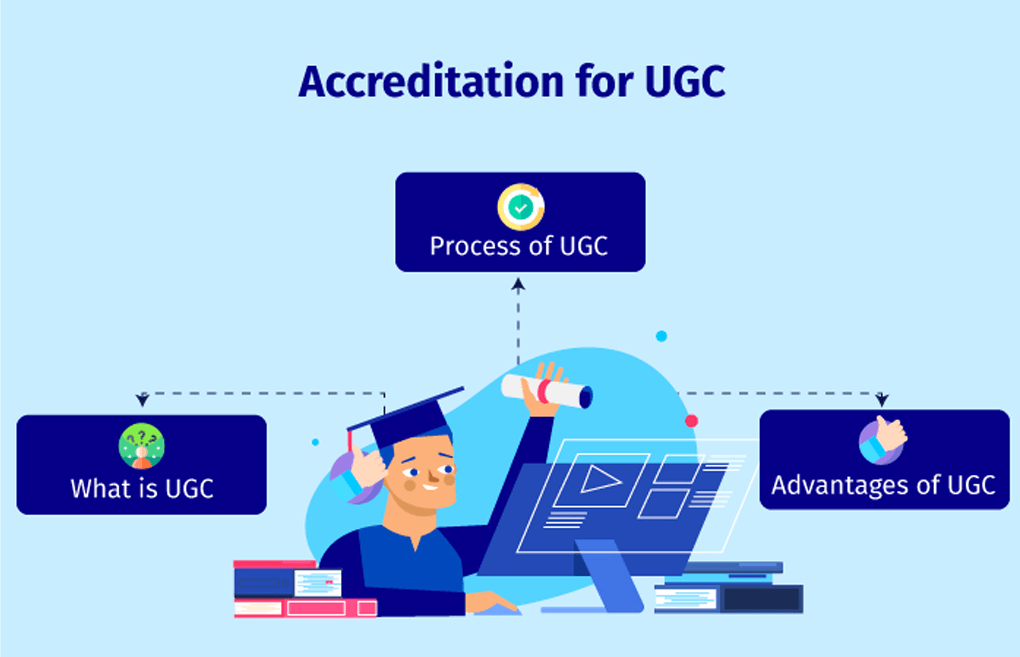
What is UGC
The University Grants Commission (UGC) is the statutory body of the government of India, which was inaugurated in 1953 by Late Maulana Abul Kalam Azad ( former minister of Education). And in November 1956, it was established as a statutory body of the government of India under the University Grants Commission (UGC) Act of the parliament. The vision was to supervise coordination, determination and maintaining the standards of education in the institutes.
UGC is responsible for providing recognition to the universities of India and disburses funds to such recognized colleges and universities. In order to provide valuable valid degree courses in India, it is mandatory for universities to get approval or accreditation of the UGC. Currently, the head office of UGC is located at Bahadur Shah Zafar Marg, New Delhi, with two additional bureaus operating from Feroze Shah Road and the South Campus of the University of Delhi as well. Moreover, it has six centers including Pune, Hyderabad, Kolkata, Guwahati, Bhopal and Bangalore to control the region-wise education system in India.
The UGC mandate involving functions and activities are as follows-
- Promote and coordinate university education.
- Set out rules and regulations on minimum education in India.
- Frame the standards of teaching, examination and research held in the universities.
- Allow grants to the universities and colleges
- Maintain the connection between the Union State government and institutes of higher education.
- Suggest the mandatory procedures to the Central and State governments for the improvement of university education.
Advantages of UGC
There are numerous advantages of UGC to recognized universities as well as the quality of the educational system in India. Some of them are as mentioned here.
The recognized universities of UGC have a streamlined examination system and uniform educational pattern. Due to strict guidelines for maintaining the standards in the universities, students can find a professional and learnable environment at the universities. Thus, it improves the overall quality of the educational system in India.
They also get the special recognition of being a deemed university from the Ministry of Human Resource Development. Moreover, such universities are considered to be unaided educational systems, which means they can offer their flexible educational plans and syllabus to the students. Even these universities are considered an integral part of the research for obtaining the deemed university status.
Process of UGC
In order to get UGC recognized, the university has to undergo a strict inspection conducted by an expert panel designated by UGC. National Assessment and Accreditation Council (NAAC) is an autonomous institution established by the University Grants Commission (UGC) under the UGC act of 1956 for accessing and accrediting the higher education systems of India.
It basically includes performance evaluation, assessment and accreditation of universities and colleges in the country. The panel evaluates the factors such as infrastructure, a vision of the management, faculty and staff, courses curriculum, policy and procedures, etc. If the institute fails to meet the necessary standards, either the application is rejected right away or the institute is given the time to meet the compliance requirements.
The process of UGC inspection is quite intense. The institute needs to send the documents and self-evaluation report to the UGC. After the approval, the panel visits the institute to check its credibility and quality. Every minute detail of the institute will be examined precisely at various levels. Furthermore, the status of UGC recognition and the detailed report of the inspection panel can be seen on the website of UGC.
Through the use of advanced technology, the Camu Digital Campus platform helps colleges and universities to achieve accreditation by UGC. It has innovative features in order to keep the track of the performance with centralized documentation services. For more detailed information about the features and benefits, connect now!
Accreditation for IGCSE School
WHAT IS THE IGCSE?
The International General Certificate of Secondary Education (IGCSE) is based on the British curriculum but it is content-rich and adapted for a more internationally-focused student body. The courses are taught in English, so a profound understanding of the English language is required to perform well in the exams.
IGCSE ACCREDITATION
Accreditation for IGCSE schools is beneficial for the schools to be officially accepted by other educational institutions globally. It provides students with a well-rounded education and a sturdy coverage of all subjects. Furthermore, IGCSE is recognized worldwide and helps the students to transit curriculum overseas easily after secondary education too.
6 Accreditation Bodies for International Schools
Here are some of the organizations that are responsible for accrediting international schools-

- Council of International Schools (CIS)-CIS is a membership community, which is based in the Netherlands intending to enhance international education through professional services to schools, higher education institutions and individuals. The schools that wish to be accredited by the CIS, need to be committed to the vision and mission for the students, focus on the quality of the learning environment and constantly try to seek improvement and expansion
- Western Association of Schools and Colleges (WASC)The Accreditation Commission for Schools (ASC) under the WASC is a body tasked with accrediting K-12 schools and postsecondary institutions in California, Hawaii and several union territories of the United States. Moreover, ASC has the authority to accredit schools in East Asia.
- ASIC School Accreditation The ASIC School Accreditation is a recognized agency by the United Kingdom Home Office, as a globally recognized standard for schools, colleges, universities and institutions. Its accreditation is focused on the school standard in terms of quality education, student achievements, practices & ethics.
- The Council of British International Schools (COBIS) It is the prime global association for International British Schools, which are outside of the United Kingdom. COBIS is allowed to provide quality assurance, professional development and network opportunities. Moreover, this association also organizes inter-school competitions, conferences and other sessions for their member schools for benefitting senior leaders, teachers, staff, support staff and students.
- International School Quality Mark Accreditation The Educational Development trust was founded in 1968 to help British teachers working overseas in terms of welfare, professional support and recruitment. Now, this agency is focusing on contributing to English-medium education in underdeveloped and developing countries. In addition to this, they have built International School Quality Mark Accreditation for an inspection of international schools. If the school meets high standards of student achievement, effective curriculum, and has a strong partnership with parents and a successful leadership team, then the school is awarded the accreditation.
- New England School Association of Schools and Colleges (NEASC) This is a non-profit membership organization, which connects more than 1500 public, private and international schools in the United States and beyond. It was established to accredit and maintain high standards for all the levels of the American curriculum. It is composed of three commissions which are independent schools, International education and Public Schools.
Accreditation Process for IGCSE Schools
The accreditation process for IGCSE schools consists of three stages-
- Stage 1- Assessment of the Application form and Accompanying Documentation
Initially, Institutions considering accreditation must download the application form from the ASIC website. This should be filled out and sent along with copies of the documentation. Then stage 1 involves the review of the documentation process by the accrediting team. If the documentation and form are acceptable, the school accreditation process will move to stage 2 otherwise the ASIC has full authority to decline the application form.
- Stage 2- Initial Inspection Visit
The stage 2 inspection will normally, as a minimum, be a one day visit by an ASIC inspector, who will examine the school’s compliance with statutory and immigration requirements, premises, health and safety, education management, teaching resources, and academic curriculum, and student records.
The inspector will meet the owner(s) of the institution to discuss the plan for the ongoing operation and development of the institution. In case, the owner is not available, this meeting should occur with the Principal and Senior Management of the institution and the owner’s visit will be deferred to Stage 3.
After the stage 2 visit, the visiting inspector will submit the report of the visit, which will decide whether to proceed further or not to Stage 3. Furthermore, it will also identify any shortcomings that the institution may need to address before Stage 3 takes place.
- Stage 3- Final Inspection Visit
During the stage 3 inspection, the number of inspectors will depend on the size of the institution and the diversity of the academic programme. Also, the inspectors will conduct meetings with the senior management team, with other staff, and with a group of students to inspect the operation of the organization. The format of the final inspection visit may vary according to the size, nature, location and complexity of the institution.
After the three processes, the report generated in Stage 3 will be checked by the Accreditation advisor, and it will be considered by the Accreditation Committee for the following outcomes-
- They will award full accreditation for a period of not exceeding four years, after which accreditation must be renewed.
- Suspend the decision with there are some weaknesses in the institution that could be rectified in a period not normally exceeding three months.
- Refuse the accreditation on the basis that the inspection inspector found serious shortcomings in the institution’s standards & practices.
Accreditation Service for IGCSE Schools
The Accreditation Services for International Schools (ASIC), colleges and universities is a voluntary, independent international education agency that provides recognition to the institution for meeting the highest standards of education. It is a quality assessment process to determine the school’s commitment to providing high-quality international education & to keep the best standards to ensure that the school is continually improving.
ASIC accreditation process consists of 8 key performance indicators namely,
- School Premises, Infrastructure and Health & Safety
- Governance, Management & Staff Resources
- Learning, Teaching & Research Activity
- Quality Assurance & Enhancement
- Student Welfare
- Awards & Qualifications
- Marketing & Type of Recruitment of Students
- Systems Management & Compliance with Immigration Regulations
Conclusion
When a school achieves accreditation for IGCSE, the process covers a lot of procedures and documentation. Camu Digital Campus leverages the power of advanced technology with a seamless user-experience dashboard that helps in auditing & generating reports to achieve the accreditation for IGCSE, CBSE, NAAC accreditation for higher education and many more at ease. For further enquiries, feel free to contact us.
Accreditation for CBSE
Introduction
Surprisingly, India is making rapid progress in the number of schools every year due to the unforeseen demands of admission enrollments. But the quality of education and the standards differ a lot from each other. However, for ensuring the quality & equivalent standards in school education, the Government of India has formed the agency named National Accreditation Board of Education & Training (NABET), which is the constituent board of the Quality Council of India.
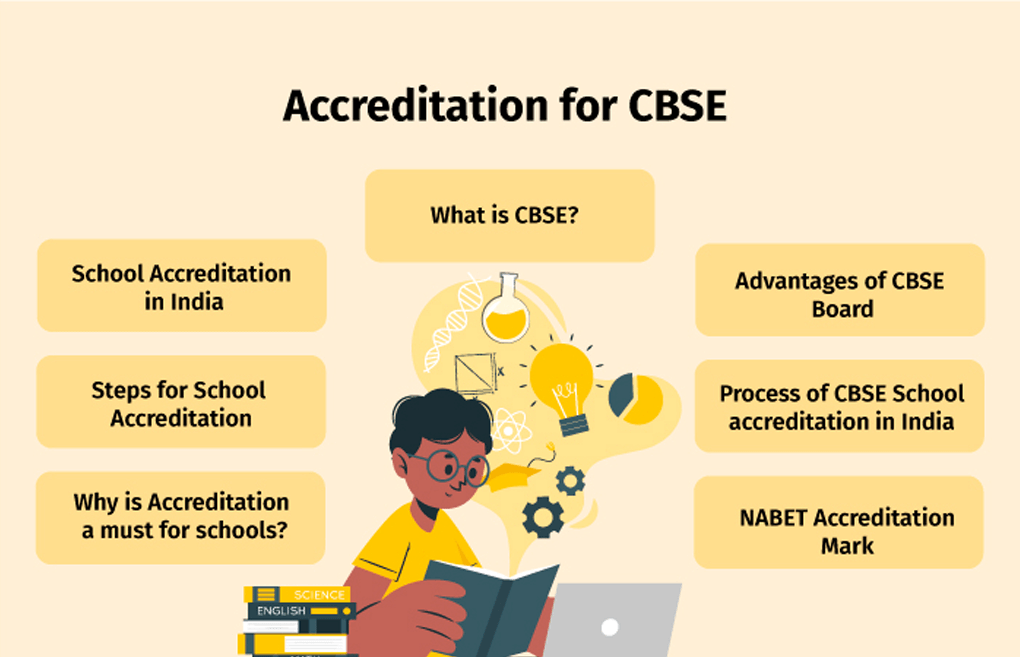
School Accreditation in India
Accreditation is the process of ensuring the schools or universities meet the specific criteria based on certain parameters including their infrastructure, academic curriculum, examination format etc. Hence, institutes must follow the strict guidelines & norms laid down by the education boards. As the NAAC accreditation is a must for universities in India, likewise accreditation for CBSE schools is provided by NABET. Furthermore, NABET has a set of frameworks and standards for Quality School governance, which applies to all the schools in India irrespective of their size, type, board affiliation and nature of educational service provided.
These standards are built to make sure the schools score high on good infrastructure, must have qualified staff, effective ratings on the educational facilities provided, examination & evaluation system, etc. However, these parameters help the schools to pursue continual excellence in providing quality education to students.
Steps for School Accreditation
Following are the steps to follow for School Accreditation:-
- The first step is to apply for accreditation by submitting the application form either online or offline. Along with this, the school has to deposit a certain amount of fees and submit a detailed report with essential documents of recognition.
- Next step, the school has to make necessary preparations for the inspection day, when there is a visit by the team of the accreditation agency. The team provides scores of evaluation based on the parameters like curriculum, extra-curricular activities, teaching environment etc.
- After evaluation, the accreditation authority provides the cumulative score to the school. Also, it may suggest further improvements if needed and give a certain time to incorporate the changes.
- Once the specified period is over, the agency visits the school again to check whether the necessary changes have been made or not. After reviewing, if the team finds that the school is meeting all the specified requirements, it agrees to provide accreditation.
- The accreditation is valid for 3 years and once this period is over, the school has to re-apply for accreditation.
Why is Accreditation a must for schools?
Accreditation is important because of the following reasons-
- It helps to ensure the educational processes of schools are competitive enough to provide the all-around development of the student.
- It standardizes the school processes and objectives as per the national requirements.
- It enhances and evolves the teaching methodologies and overall quality of education in schools.
- Design effective structure for school education management system and performance evaluation of students.
What is CBSE?
The Central Board of Secondary Education (CBSE) is a national level educational body for both public and private schools that is under the direct control of the government of India. CBSE has earned the highest reputation in terms of education board and being a school affiliated with CBSE is an assured factor of growth in coming years. It is the oldest Indian educational board with headquarters in New Delhi and along with regional offices.
Advantages of CBSE Board
- The recognition by the Government of India provides better credibility to the schools.
- The CBSE syllabus is easy in the English language and is more scientific and focused in approach.
- Moreover, the CBSE syllabus is competitive and helps the students to usually do better in competitive examinations such as IIT-JEE etc.
- The CBSE curriculum is designed with extracurricular activities that have a wider network at both state and national levels. This helps the students to develop their overall personality too.
Process of CBSE School accreditation in India
- Firstly, the schools need to refer to the website from time to time to keep themselves updated with the policies, schemes & amendments.
- Along with this, the schools intending to get accredited must make sure that they have a website with an ‘Accreditation Corner’ as prescribed by the CBSE and must upload the Mandatory Disclosure form as available on the CBSE website.
- Next, the schools need to form a School Assessment Committee(SAC), in which the principal is the head of the committee. Also, must fill out the ‘Form of Intent’ and submit it to CBSE.
- After the acknowledgement from the CBSE or NABET agency, the school should fill the online School Quality Assessment & Assurance (SQAA) instruments after reading its manual.
- After the completion of documents, the school must prepare for hosting the Peer Assessment Team(PAT) for visiting physically.
- The schools would be given the School Quality Enhancement Report (SQER) after the visit, which should be gone thoroughly and necessary actions should be taken for improving the teaching and learning environment.
- A school which gets a score of 75% or above and a minimum of 50% shall be declared accredited by CBSE. The school’s name shall be then listed on the CBSE website under the list of accredited schools. Even schools can use the terminology “ affiliated and accredited by CBSE”.
- The SQAA accreditation expires within 3 years. So, a fresh renewal application should be made by the schools before the expiry to enjoy the privilege.
NABET Accreditation Mark
Once the school is accredited by NABET, it can use it in any of the media of communications such as school letterhead, newsletters, annual reports, brochures, promotional materials, business cards, advertisements etc. In case of expiry or withdrawal of accreditation, the school must discontinue the use of NABET accreditation marks.
Conclusion
The accreditation and affiliation by CBSE is a cumbersome process involving many compliances and must be performed under expert supervision. We, Camu Digital Campus, have a team of experts, which help in achieving school accreditation as well as accreditation for higher education in a simpler and hassle-free process. For more queries about CBSE accreditation & affiliation, don’t hesitate to contact us.
The accreditation and affiliation by CBSE is a cumbersome process involving many compliances and must be performed under expert supervision. Camu Digital Campus, is the best ERP software, which helps in generating the reports & documents required while achieving the school accreditation as well as accreditation for higher education in a simpler way. For more queries about CBSE accreditation & affiliation, don’t hesitate to contact us.
Accreditation for NBA
The higher educational institutions must be accredited by reputed organizations such as NBA or NAAC to create a great educational impact & great standards for institutional practices. Also, the accreditation acts as a quality assurance for students and on the other side, it opens the door to opportunities for institutions to get grants or funds from the government for enhancing the operational processes in an institution.
In this article, will explore what is NBA, its benefits and the process of accreditation for the NBA. So, squeeze into reading, without any further ado.
What is NBA
The National Board of Accreditation (NBA), India was established in September 1994, under the All India Council of Technical Education (AICTE) in order to examine the qualitative evaluations of technical institutions and programs based on specified norms and standards. It is one of the autonomous accreditation bodies in India, which has the authority of accrediting engineering colleges & various technical institutions based on the quality of education being offered. The disciplines that fall under the eligibility criteria for NBA accreditation are Engineering & Technology, Management, Tourism, Architecture, Hospitality, Computer Applications, Pharmacy, management, and applied arts and crafts.
Advantages of NBA
The following are some of the key benefits of NBA accreditations for higher education & institutions.
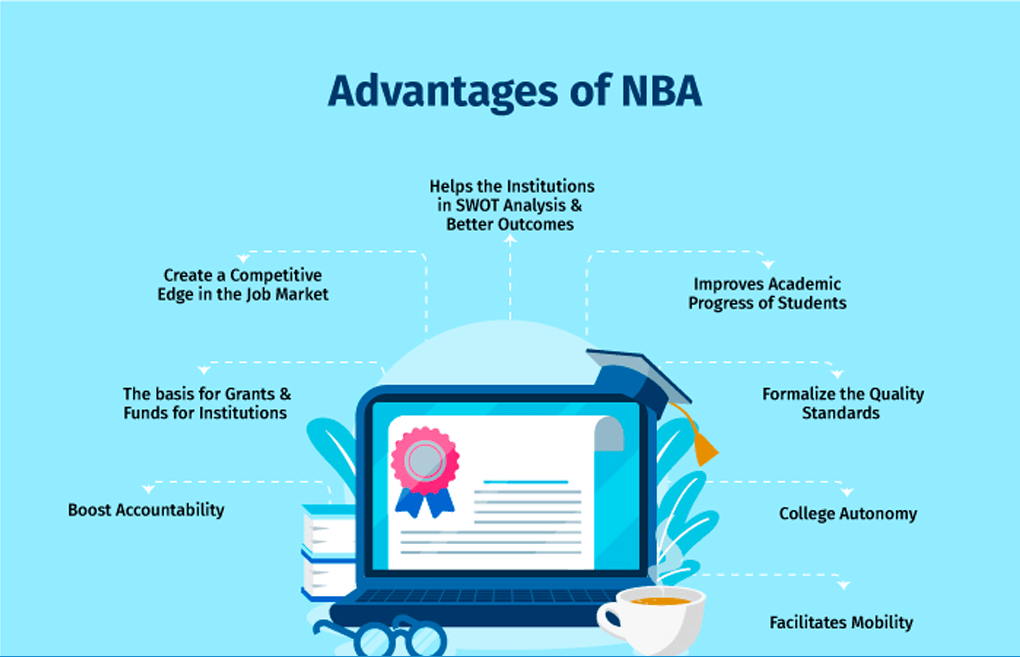
- Helps the Institutions in SWOT Analysis & Better OutcomesAccreditation by NBA helps the technical institutions to process SWOT analysis i.e. evaluating their strengths, weaknesses & opportunities. It enables the institutions to understand where they stand right now and helps in building strategies to overcome the gaps and maximize student learning.
- Improves Academic Progress of Students The NBA Accredited institution uses Outcome-Based Education (OBE) to map and measure student progress at every step in terms of knowledge, skills and attitude.
- Formalize the Quality StandardsAccreditation for the technical institutions signifies that the program outcomes of NBA-approved colleges are met with the highest quality standards. This is an indicator of the aspiring students of the college’s commitment to excellence.
- College AutonomyThe colleges that are awarded as NBA accredited can apply and attain autonomous status. Thus, they can work independently without any need of the university.
- Boost Accountability Accreditation for NBA makes it mandatory for the institutions to meet the stringent quality standards. This in turn increases the trust, and confidence and enhances the accountability of colleges among the public and the students.
- The basis for Grants & Funds for InstitutionsThe NBA Accreditation helps the institution to avail funds from the government for the betterment of overall performance and work processes.
- Create a Competitive Edge in the Job MarketOne of the biggest benefits of NBA accreditation is that more companies will be interested and are beneficial to participate in the college placement programs. Thus, this will be advantageous to the students who have passed out from the accredited college in finding the appropriate employment.
- Facilitates MobilityNBA’s accreditation or membership provides the colleges with an opportunity to benchmark the quality of technical education offered in India with that of other member countries. This promotes and eases the possibility of mobility of graduates and professionals at the international level for employment or further studies.
Process of NBA accreditation
The NBA Accreditation process is followed by certain steps as listed below-
-
- #Step 1: Online RegistrationThe foremost step for Higher Education Institutions to receive accreditation for NBA is to get registered by submitting the basic institution details with a registered email id on the ‘eNBA’ portal.
- #Step 2: Submission of Institution Details The permanent user Id is created with password credentials by paying 10% of the registration fees. Utilizing this id, the institution needs to fill furthermore details such as the name of the head of the institution, details regarding the key promoters, institution bank details proposed programs along with the soft copies of AICTE approval letters or any suitable regulatory authority.
- #Step 3: Self-Assessment Report (SAR) Generation Once the details are submitted, then the institution needs to prepare a self-assessment report of its internal work processes and activities. The higher educational institutions need to submit them online along with paying the remaining 90% of registration fees and this procedure is known as ‘e-SAR’.
- #Step 4: NBA Peer Team VisitOnce there is a successful submission and acceptance for the NBA accreditation, the NBA peer team visits on a predefined day and evaluates and accesses the campus on every detail as per the SAR.
- #Step5: Analysis & Evaluation By Committee MembersThe evaluators create the report based on the assessment and analysis. It covers the areas or parameters such as Mission, Vision & Program Educational Objectives (PEO), the curriculum of the program, program outcomes, technical support & facilities, the performance of students, teaching staff resources, financial resources, institutional support and governance. Based on this evaluation, if the college scores well, then they are awarded NBA Accreditation.
Summing Up!
If institutions are facing challenges in filling out the form, documents, information and compliance report for the NBA accreditation then Camu Digital Campus is the one-shot ERP software to facilitate the process. Get in touch to know more – [email protected]


